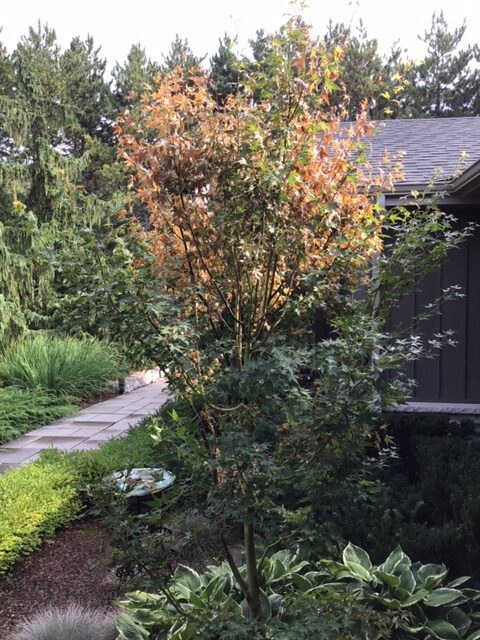
Hello, I am in Zone 5 and this Japanese maple has been planted in this location for 4 years. We have a French drain that diverts the roof rain water away from this area. However, this summer the rainfall has been excessive so I am worried the eves could not take the sudden water and has spilled over to this garden. At first I thought these tree showed signs of root rot. However, now I am wondering if this could be verticillium wilt? The stems are turning black and the leaves are dying from the top down. If so, can I save this tree? If not, can I amend the soil to allow for another Japanese maple?
Based on your image, it could be verticillium wilt. The first thing to do is confirm if this is the case, as it will determine your course of action.
According to Michigan State University Extension (in partnership with USDA), symptoms of other problems can be mistaken for verticillium wilt; they list leaf blight, leaf scorch and root damage. This same statement is made by Vertrees & Gregory in Japanese Maples (3rd Edition, Timber Press). You could confirm the diagnosis by pruning an affected branch to examine the tissue inside for the characteristic bluish-green or brown streaks in the wood. Bartlett Tree Service provides a helpful, downloadable PDF to show you what to look for. Make sure you sterilize your pruning tools, between cuts and when you’ve finished. Do not compost, use as mulch or put affected wood in yard-waste pick-up; it should go in regular garbage.
https://www.bartlett.com/resources/technical-reports/Verticillium-Wilt-on-Woody-Landscape-Plants
It is possible that the affected wood is well below where you prune a sample. For absolute certainty, you would need to have a sample of the wood tested. University of Guelph lists verticillium wilt confirmation test on the service roster, but it would be best to contact them to confirm they provide this service to home gardeners. You can review their instructions for collecting and submitting samples here:
https://afl.uoguelph.ca/submitting-samples
If verticillium wilt is confirmed, you can expect the pathogen to persist for up to 10 years in the soil. Because all maples are susceptible to this fungus, it would be best to plant something that will not be affected. Unfortunately, this would excludes some lovely smaller trees that could be pruned to emulate the beautiful form of Japanese maples, such magnolia, smokebush and redbud. Coniferous trees are not susceptible. A list of resistant deciduous trees and shrubs may be found at the end of this article from Wisconsin University Extension:
https://hort.extension.wisc.edu/articles/verticillium-wilt-of-trees-and-shrubs/
If you want to go to the trouble and expense of treating the soil, you could try the solarization–placing black plastic over the spot. The problem with this would be that the fungus likely extends beyond the space the trunk is taking in the garden bed. Landscape Ontario published in 2013 a synopsis of a study for treating soils where Maple wilt occurred. The best outcomes were from mustard meal applications, though you would need to contact the study authors for details as to application. The other promising treatment is described below; for the full article, see link below:
BSD involves incorporating large volumes of organic amendments to soil, wetting the soils to saturation, and then covering them with plastic to create anaerobic conditions. Maples planted in BSD soil treatments showed 85 per cent reductions of soil inoculum levels of V. dahliae relative to the control. The numbers did not increase over four years. Nematode populations, which can exacerbate wilt disease, were also reduced by 95 to 99 per cent.
https://horttrades.com/managing-verticillium-wilt-of-maples-using-organic-amendments
If you opt to plant a new wilt-resistant tree, it would be best to evaluate how much water is being delivered to the soil in this spot. You can dig a narrow-diameter hole to a 12-inch depth; most trees have feeder roots that are in the top 10-12 inches of soil. You could also use an indoor plant moisture meter or invest in a compost moisture meter which have longer wands than the indoor plant variety. Make sure to test the moisture both in a dry spell and directly after a heavy rain, as this will give you both ends of the spectrum. Based on the outcome of this test, you will be able to eliminate leaf scorch if the soil has consistent moisture, or begin a watering regimen that delivers 1 inch of water per week, and see if the condition improves. Plant blights are cause by bacterial or fungal infections. Blight could not be confirmed as a disease of the leaves only, or common to Japanese maples.

